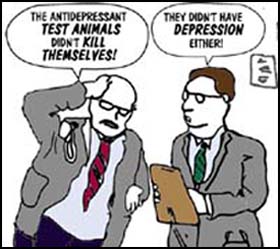 It would be laughable if it weren’t tragic. This week, Surgeon General Regina Benjamin introduced a plan to stem the nation’s growing suicide rate without addressing the nation’s growing use of suicide-linked drugs.
It would be laughable if it weren’t tragic. This week, Surgeon General Regina Benjamin introduced a plan to stem the nation’s growing suicide rate without addressing the nation’s growing use of suicide-linked drugs.
Antidepressants like Prozac and Paxil, antipsychotics like Seroquel and Zyprexa and anti-seizure drugs like Lyrica and Neurontin are all linked to suicide in published reports and in FDA warnings. (Almost 5,000 newspaper reports link antidepressants to suicide, homicide and bizarre behavior.) Asthma drugs like Singulair, antismoking drugs like Chantix, acne drugs like Accutane and the still-in-use malaria drug Lariam are also linked to suicide.
The US’s suicide rate has risen to 38,000 a year, says USA Today, after falling in the 1990s. The rise correlates with the debut of direct-to-consumer drug advertising in the late 1990s, the approval of many drugs with suicide links and more people taking psychoactive drugs for lifestyle problems.
Dr. Benjamin announced that federal grants totaling $55 million will save 20,000 lives in the next five years through suicide hotlines, more mental health workers in the VA, better depression screening and Facebook tracking of suicidal messages. Nowhere, including in the suicide-racked military, does she suggest looking at the overmedication which has gone hand-in-hand with the deaths. A month earlier, it was announced the Army has awarded $3 million to a scientist to develop a thyroid related nasal spray to combat suicidal thoughts, also ignoring overmedication.
Suicide increased more than 150 percent in the Army and more than 50 percent in the Marine Corps between 2001 and 2009, reported Military Times, displaying graphs of the suicide and prescription drug increases, in a print edition, that are similar enough to be laid over one another. One in six service members was on a psychoactive drug in 2010 and “many troops are taking more than one kind, mixing several pills in daily ‘cocktails’ for example, an antidepressant with an antipsychotic to prevent nightmares, plus an anti-epileptic to reduce headaches—despite minimal clinical research testing such combinations,” said Military Times.
Eighty-nine percent of troops with post traumatic stress disorder (PTSD) are now given psychoactive drugs and, between 2005 and 2009, half of all TRICARE (the military health plan) prescriptions for people between 18 and 34 were for antidepressants. During the same period, epilepsy drugs like Topamax and Neurontin, increasingly given off-label for mental conditions, increased 56 percent, reports Military Times. In 2008, 578,000 epilepsy pills and 89,000 antipsychotics were prescribed to deploying troops. What?
Nor is the suicide rate going down as troops withdraw from Iraq and Afghanistan. In July, 2012, there were 38 Army suicides says USA Today and in July of 2011, there were 32. According to the Army’s in-depth Health Promotion, Risk Reduction and Suicide Prevention Report in 2010, 36 percent of the troops who killed themselves had never even deployed.
Why are such drugs, which affect reaction time, motor skills, coordination, attention and memory even allowed during active duty? And why are they prescribed to soldiers who are at the exact age—young adults—that is most at risk for suicide, according to warning labels?
Nor are troops the only cash cows for Big Pharma. One in four women are on psychoactive drugs, according to published reports, and millions of children are on psychoactive drugs, especially poor and those with disability status.
When the FDA first put suicide warnings on antidepressants for young people in the mid 2000s, Big Pharma linked psychiatrists like Charles Nemeroff argued that suicides would go up if doctors and patients were scared off by the black box warnings. Though the argument was absurd—is the nation fat because fen-phen was withdrawn?—the theory got play in the mainstream and medical press until it was proven wrong.
Yet as the surgeon general and HHS proved this week, the government is still in denial about suicide and the elephant in the room called Big Pharma. Instead of spending millions on counselors, crisis lines, and “awareness campaigns” why doesn’t it look at the millions it’s spending on suicide-linked drugs?
 More information about overmedication of troops and suicide-linked drugs is found in Martha Rosenberg’s recently published Born With a Junk Food Deficiency: How Flaks, Quacks and Hacks Pimp The Public Health available at Barnes & Noble, on Amazon and at public and school libraries.
More information about overmedication of troops and suicide-linked drugs is found in Martha Rosenberg’s recently published Born With a Junk Food Deficiency: How Flaks, Quacks and Hacks Pimp The Public Health available at Barnes & Noble, on Amazon and at public and school libraries.



My relatives all the time say that I am wasting my time here at web, however I know I am getting know-how daily by reading thes good content.
regards
Propolis
I leave a response when I especially enjoy a article on a
website or if I have something to contribute to the discussion.
Usually it’s caused by the fire displayed in the post I read. And on this post Government.